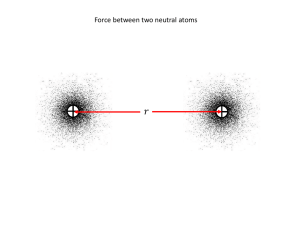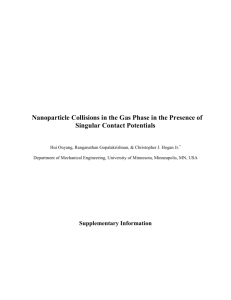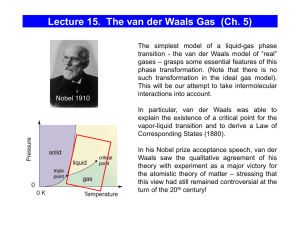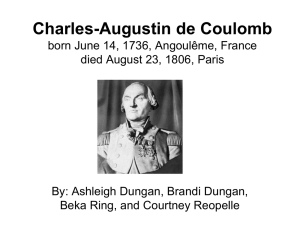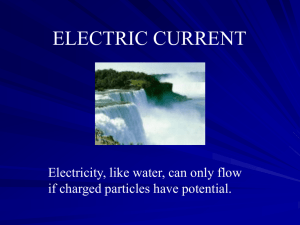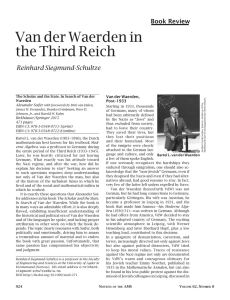Some last thoughts on Van der Waals (VDW) interactions
advertisement
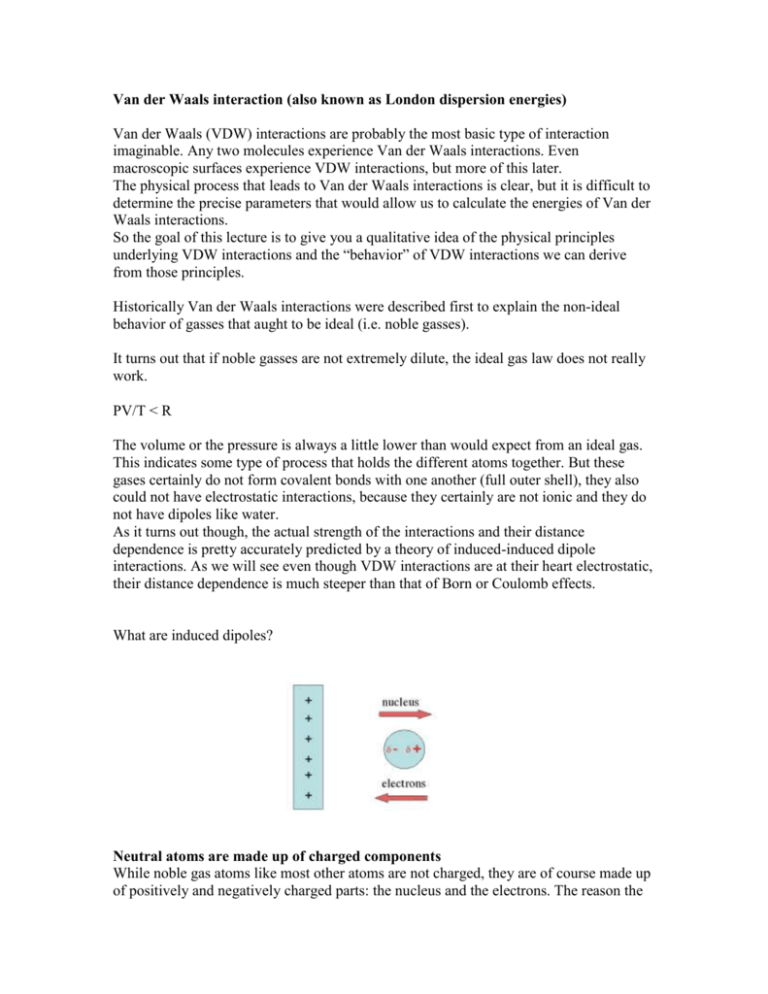
Van der Waals interaction (also known as London dispersion energies) Van der Waals (VDW) interactions are probably the most basic type of interaction imaginable. Any two molecules experience Van der Waals interactions. Even macroscopic surfaces experience VDW interactions, but more of this later. The physical process that leads to Van der Waals interactions is clear, but it is difficult to determine the precise parameters that would allow us to calculate the energies of Van der Waals interactions. So the goal of this lecture is to give you a qualitative idea of the physical principles underlying VDW interactions and the “behavior” of VDW interactions we can derive from those principles. Historically Van der Waals interactions were described first to explain the non-ideal behavior of gasses that aught to be ideal (i.e. noble gasses). It turns out that if noble gasses are not extremely dilute, the ideal gas law does not really work. PV/T < R The volume or the pressure is always a little lower than would expect from an ideal gas. This indicates some type of process that holds the different atoms together. But these gases certainly do not form covalent bonds with one another (full outer shell), they also could not have electrostatic interactions, because they certainly are not ionic and they do not have dipoles like water. As it turns out though, the actual strength of the interactions and their distance dependence is pretty accurately predicted by a theory of induced-induced dipole interactions. As we will see even though VDW interactions are at their heart electrostatic, their distance dependence is much steeper than that of Born or Coulomb effects. What are induced dipoles? Neutral atoms are made up of charged components While noble gas atoms like most other atoms are not charged, they are of course made up of positively and negatively charged parts: the nucleus and the electrons. The reason the atom appears neutral to the outside, is because the electrostatic fields from the electrons and the nucleus are co-centric and cancel each other out. External fields induce dipoles AND attract them Lets take such a neutral atom and place it next to a positive charge. This charge will pull the atom’s electrons towards this charge and push the nucleus away. The result is an induced dipole. Now, the negatively charged end of the dipole is a little closer to the external positive charge and therefore interacts with it a little bit stronger than the positive end of the dipole, which is a little bit further away. The result is a net attraction of the dipole to the surface. Here is how we can calculate the energy of attracting this dipole to a charge. Notice that the derivation used below only works for r >r. u(r) coulomb | u(r) coulombattract | | u(r) coulombrepell | | q | | q | | q | | q | 4 o D(r r) 4 o D(r r) | q | | q | 1 1 u(r) coulomb 4 o D (r r) (r r) | q | | q | (r r) (r r) u(r) coulomb 1 4o D (r r) (r r) (r r) (r r) | q | | q | (r r) (r r) u(r) coulomb 1 4o D (r r) (r r) | q | | q | 2r u(r) coulomb 1 4o D (r r) (r r) u(r) coulomb u(r) coulomb | q1 | | q | 2r 4o D r 2 r 2 Looking at the Equation for dipole-charge interaction 1) The larger the distance r between the two charges in the dipole, and the larger the two charges, the greater the net attraction. So large soft atoms (i.e. sulfur) or systems in which electrons can be displaced over large distances (i.e. cofactors with conjugated pi electron systems) are more polarizable and will be more strongly attracted by a charge via charge-induced-dipole interactions. 2) The shorter the distance the larger the interaction. We know this from chargecharge interactions. But now the distance dependence becomes 1/r2. Interaction energies between static dipoles scale with 1/r3 If we now have an interaction between two dipoles we can still calculate the interaction energy from the Coulomb equation. u(r) coulomb | u(r) coulombattract | | u(r) coulombrepell | | q1 | | q2 | | q1 | | q2 | | q1 | | q2 | u(r) coulomb 2 4o D(r 2r) 4 o D(r 2r) 4 o Dr If you go through the process of solving this entire equation you will find that the coulombic interaction energy is proportional to 1/r3. Thermal motions reduce the distance dependence even further In addition to these purely geometric effects, we have an additional effect, which comes from the time averaging of the dipoles. This time-averaging can be modeled as a random reorientation of the atomic dipoles. (This actually turns out to be another Boltzmann distribution type problem – rotational energy vs. an order inducing external potential). If I would show you the full derivation, which I am almost positive you don’t want to see, you would see how biased rotational averaging of an interaction reduces that interaction in such a way that the distance dependence gets raised to the second power so we end up with an overall distance dependence of 1/r6 . (If you absolutely have to see the derivation, you can see it on pages 452 in Ken Dill’s “Molecular Driving Forces”). Even though VDW interactions are electrostatic in nature, their distance dependence is 1/ r6. Using a simple model, you have just seen how we can explain VDW interactions based on interactions between induced dipoles. The result is a bit surprising: VDW interactions are extremely short ranged; they only have an effect if the atoms are touching each other directly. This favors the really tight packing seen in protein interiors. And as a matter of fact in any condensed matter. Protein interiors are about as tightly packed as hydrocarbon crystals. The atoms are stopped form getting even closer only by quantum mechanical interactions that prevent electrons from non-bonded atoms to occupy the same space. This repulsion is very strong and has even higher-order distance dependence. This repulsive distance dependence is usually modeled as a term that scales with 1/r12 even though there is absolutely no physical reason for the 1/r12 term or the magnitude of A. This results in the famous Lennard-Jones Potential. Unon-polar(r) = A/r12- B/r6 The effect of VDW interactions if difficult to quantify in proteins Ultimately it is very difficult to get good numbers for VDW interaction energies. The reason lies partly in the steep distance dependence. A small error in distance leads to a huge error in energy. The other problem is that it is difficult to find compounds or conditions under which one can measure VDW interactions independently. A rough idea of the magnitude of VDW interactions is given by the heat of sublimation of aliphatic hydrocarbons. These compounds do not form hydrogen bonds, do not have charge-charge interactions etc. So their Enthalpies of sublimation are thought to be almost exclusively determined by VDW interactions. Methane Ethane Propane Butane n-Pentane n-Hexane 2.3 kcal/mol 4.9 kcal/mol 6.7 kcal/mol 8.6 kcal/mol 10.5 kcal/mol 12 kcal/mol Some last thoughts on Van der Waals (VDW) interactions As we see from the table above, Van der Waals interactions deliver substantial energies. The problem is that Van der Waals interactions exist between virtually all molecules to a similar extent. So in an unfolded protein we may have lots of VDW interactions between water molecules and protein sidechains but upon protein folding we simply have interactions between amino-acid side-chains. Also, VDW interactions have such steep distance dependence that it is very rare to get experimental structures precise enough to calculate VDW interaction energies reliably on an atom-to-atom basis. In particular, hydrogen atoms mediate the bulk of VDW interactions in proteins and in most crystal structures we have no experimental information on the position of hydrogen atoms. So the most useful way to think about Van der Waals energies is in terms of packing energy and packing density. If a material, such as the interior of a protein, is very densely packed, then we get quite a bit of VDW energy from this packing. If the packing is not perfect, that packing energy falls of very quickly. Just as a preview for future classes, the type of perfect packing required for high VDW energy also severely restricts the conformational entropy. So conformational entropy and VDW packing energies are in a constant trade off. Fun with VDW forces Finally as a bit of entertainment and to show you that VDW interactions are real and pretty strong here is a picture of a Gecko and its foot. Yes you guessed it; Geckos get their ability to stick to virtually any surface from VDW interactions. The trick is to get enough of the area of two contacting surfaces so close together where VDW interactions start to become effective. Since the interaction energies fall of with 1/r6 this means close to within a fraction of an Angstrom. The gecko does this by having superfine, flexible bristles under its feet that press very tiny protrusions, called spatula, onto surfaces, even if those surfaces are quite rough at the molecular level. It has been calculated that if a all of those spatula would make full contact to the surface the VDW interactions would be strong enough to hang a 200 pound weight from a single Gecko toe! To learn more about Geckos and Van der Waals interactions you may want to look at: Autumn, Sitti, Liang et al. Evidence for van der Waals adhesion in gecko setae PNAS, 99, pp. 12252-12256 (2002)
